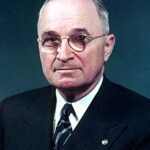The Decision Behind European Recovery
President Truman announced the Marshall Plan on June 5, 1947, responding to Europe’s economic devastation. The continent faced widespread hunger, unemployment, and political instability after World War II. Secretary of State George Marshall outlined the comprehensive aid program at Harvard University. The initiative offered financial assistance to any European nation willing to cooperate in recovery efforts.
Economic Foundation of the Marshall Plan
Congress approved $13 billion in aid over four years, equivalent to $150 billion today 💰. The program targeted infrastructure, industrial capacity, and agricultural production across Western Europe. Sixteen nations participated, including Britain, France, West Germany, and Italy. The aid came with conditions requiring economic cooperation and democratic governance. Recipients had to reduce trade barriers and increase productivity measures.
Strategic Implementation Process
The Marshall Plan required detailed economic planning and coordination between nations 📊. American advisors worked directly with European governments to allocate resources effectively. The program prioritized steel production, transportation networks, and energy systems. Aid flowed through grants rather than loans, reducing European debt burdens significantly.
Impact:
Immediate Economic Transformation
The Marshall Plan achieved remarkable success within its first two years of operation. European industrial production increased by 35% above pre-war levels by 1950 📊. Agricultural output recovered fully, ending widespread food shortages across participating nations. Unemployment dropped significantly as factories reopened and infrastructure projects created jobs. The program generated $33 billion in economic growth, far exceeding the initial investment.
Geopolitical Consequences and Soviet Response
The initiative effectively contained Soviet expansion into Western Europe during critical post-war years 🌍. Stalin rejected participation and forced Eastern European satellites to refuse aid offers. This decision solidified the division between Eastern and Western Europe permanently. The Marshall Plan strengthened NATO alliances and created lasting democratic partnerships. European nations aligned more closely with American foreign policy objectives.
Long-term Historical Legacy
The program established America as the dominant global economic power after World War II. It created the foundation for European integration, leading eventually to the European Union. The Marshall Plan became the model for future American foreign aid programs worldwide. Historians consistently rank it among the most successful foreign policy initiatives in American history 🌍. The program demonstrated that economic aid could achieve strategic objectives more effectively than military intervention.
